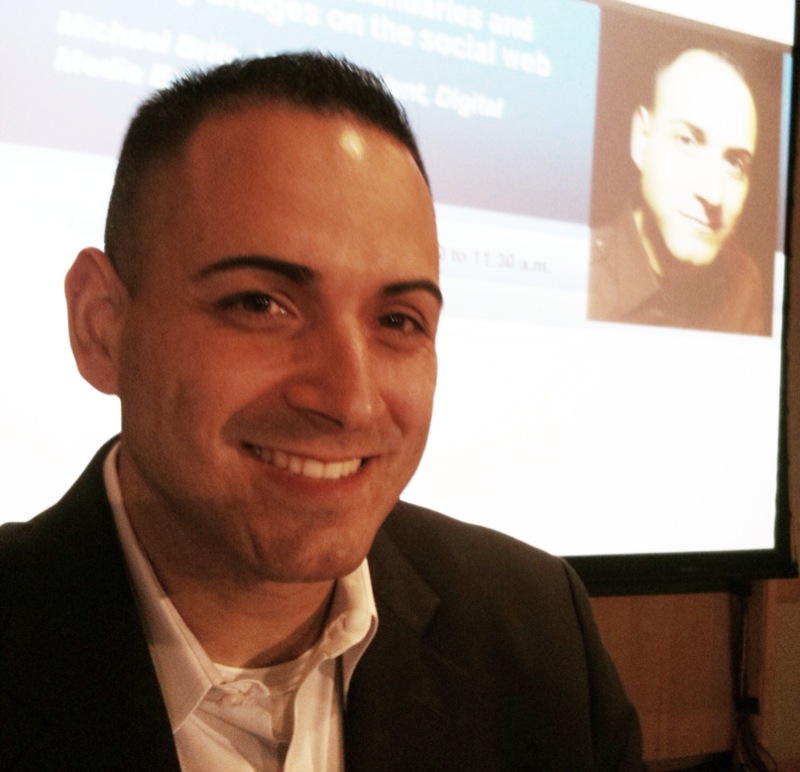 Michael Brito from Edelman Digital talked this morning at the Ragan Cisco Social Media Summit on the topic of “Brands Breaking Boundaries.”
Michael Brito from Edelman Digital talked this morning at the Ragan Cisco Social Media Summit on the topic of “Brands Breaking Boundaries.”
Michael came to Edelman from Intel and understands the issues that corporate social media communicators face. Michael, by the way, is a great guy and one of the first people who reached out and connected with me when I took the social media manager job at SAS.
He led off by referring to a study by Cone that showed in 2008, 59 percent of Americans used social media to interact with brands. In 2009 that number was up to 78 percent.
“Brands are getting smarter,” MIchael said. “We need to participate.”
It’s about the people, not the tools. The tools come and go, but the relationship among consumer, end user and brand endures. “Consumers’ expectations aren’t changing.”
How do you live up to customer expectations? Apple does it by delivering great products. They don’t pay much attention to their customers in social media because they don’t need to.
You provide superior customer service, like @ComcastCares does by engaging with its customers and providing customer service on Twitter.
You establish emotional connections, the way that Earth Justice does by engaging with customers on Foursquare.
You participate in authentic community engagement, the way Cisco does on Twitter, YouTube and their communities.
“We’ve been talking about authenticity for many years. It’s more than that.” We make mistakes but we understand the idea of being real. It’s about being believable.
For brands to become believable, it can take years of engagement. You can be authentic all you want and never really say anything of value to consumers.
“It’s not just listening.” There are hundreds of tools we can use to listen, but you actually have to act. It can become an issue if you acknowledge and listen and solicit feedback and never engage or fulfill the promise. You become believable by listening and acting.
Altimeter Group did an audit of brands by their level of engagement, not just the number of social media presence, but whether they were responding and engaging. They looked at the past 12 months of financial results and found the brands that were highly engaged were seeing up to 12 percent increases in revenue. The brands that were least engaged were seeing declines up to six percent.
Starbucks solicited feedback from mystarbucksidea.com and turned one idea into the “splash stick,” which helps keep you from spilling coffee on your shirt.
GM had planned a Buick crossover vehicle, built a prototype and solicited input from customers who felt it didn’t align with the Buick brand. Buick cancelled production.
Michael showed the Intel videos that turned Ajay Bhatt, co-inventor of the USB, into a rock star. It created a huge community demand for the Ajay t-shirt shown in the video. They pushed management to create the t-shirts in two to three weeks. They created 100 t-shirts featuring the real Ajay (he was played by an actor in the video) and did a Twitter giveaway.
The people who won the t-shirts have become brand advocates, and Intel built a great deal of brand equity.
Michael closed his prepared remarks with a list entitled, “You know your brand is socially relevant when”:
- Consumers interact spontaneously with each other and the brand is the core focus of each interaction.
- Your content is being shared all over the interwebs without you even asking.
- The meaning of your brand evolves and you embrace it.
- Consumers develop a new language around your brand and you learn it.
- Consumers find and promote new uses of your brand and you don’t sue them.
- Normal users become brand advocates and you love them for it.
- A community is born and you participate in it.
1 Comment
Very insightful presentation. By the definition of knowing when your brand is socially relevant then Cisco is very socially relevant. This definition should be used for a study of the major brands, as against just the "presence" or the Altimeter survey - would be fascinating.
The comment about Apple really struck me, because it had been on my mind. I've been a fan of promoting social media as a way of speeding customer development and business innovation. But I couldn't fit this model to Apple as I was also thinking that they just don't do it that way, but I wasn't really sure that I had the right idea here. I mean, I use an iPhone, but I find Apple extraordinarily remote, aloof, and uninterested in their customers.
Fundamentally, unlike the @ComCastcares example, Apple just don't care. But they are growing and returning nice profits, Microsoft shareholders eat your hearts out. So they innovate from within and rely on their own internal view of the market and success, and they just let Apple advocates deal with those who have problems.
It's successful for them, but I don't think it is a model for 98% of companies. Put Apple in the 1% like them which includes "creativity" in their innovation mix, 1% do it from inventions and their commercialization, but the 98% need to do business innovation "creativity not required" and they'll be successful. That's my current thoughts at least!
Walter Adamson @g2m
http://xeesm.com/walter